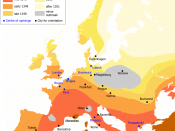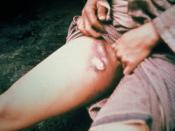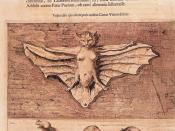Artists of the 1300s depicted death as the Grim Reaper, a skeleton on horseback whose scythe cut people down. Approximately one - third of the population of Europe died of the deadly disease known as the bubonic plague.
The plague began in Asia. Traveling the trade lanes, it infected most of Asia and the Muslim world. Inevitably it reached Europe. In 1347, a fleet of Genoese merchant ships arrived in Sicily carrying a dread cargo. This was the disease that became known as the Black Death. It got the name because of the purplish spots it produced on the skin. The disease swept through Italy. From there it followed trade routes to France, Germany, England, and other parts of Europe.
Unlike catastrophes that pull communities together, this epidemic was so terrifying that it ripped apart the very fabric of society. Giovanni Boccaccio, an Italian writer of the time, described its effect.
The bubonic plague was just one of the several lethal diseases that have swept from one society to another throughout history. Such diseases as smallpox and influenza have wiped out huge numbers of people and virtually destroying civilizations. The spread of disease has been a physical and very tragic result of cultures interacting with one another across place and time.
Frightened people looked around for a scapegoat. They found one in the Jews, who were blamed for bringing on the plague by poisoning the wells. All over Europe, Jews were driven from their homes or, worse, massacred.
The bubonic plague took about four years to reach almost every corner of Europe. In any given community, approximately three-quarters of those who caught the disease died. Before the bubonic plague ran its course, it killed almost 25 million Europeans and many more millions in Asia...


